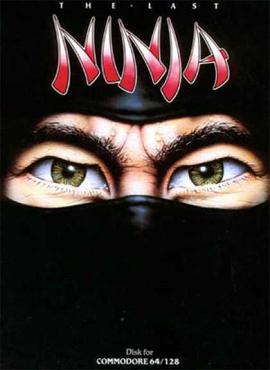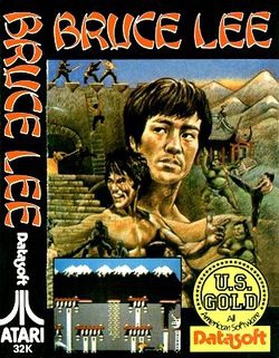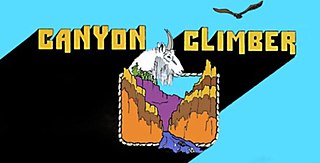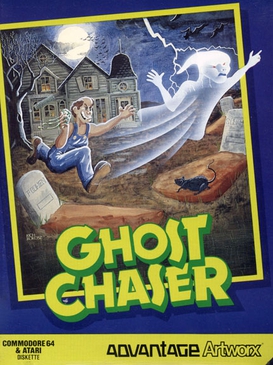
Road Runner is a racing video game based on the Wile E. Coyote and Road Runner shorts. It was released in arcades by Atari Games in 1985.

Mercenary is a 3D action-adventure game written for the Atari 8-bit computers and published by Novagen Software in 1985. It was converted to the Commodore 64, ZX Spectrum, Amstrad CPC, Atari ST, Amiga, and Commodore 16/116/Plus/4. The game uses vector graphics renderings of vast, sparse environments and has open-ended gameplay. It was also released as Mercenary: Escape from Targ and Mercenary: A Flight Simulator Adventure.

The Sentinel, released in the United States as The Sentry, is a puzzle video game created by Geoff Crammond, published by Firebird in 1986 for the BBC Micro and converted to the Commodore 64, Amstrad CPC, ZX Spectrum, Atari ST, Amiga and IBM PC compatibles. The Sentinel was among the first games to use solid-filled 3D graphics on home computers. It won numerous awards upon release and has since appeared on several "best video games of all time" lists.

The Eidolon was one of two games that were part of Lucasfilm Games' second wave in December 1985. The other was Koronis Rift. Both took advantage of the fractal technology developed for Rescue on Fractalus!, further enhancing it. In The Eidolon, Rescue's fractal mountains were turned upside down and became the inside of a cave.

The Dallas Quest is a graphic adventure game based on the television soap opera Dallas. The game was programmed by James Garon for the TRS-80 Color Computer and published by Tandy Corporation in 1984. It was the second game in the "Animated Adventure" series, following The Sands of Egypt, and uses the same split-screen display. Datasoft published versions for the Apple II, Atari 8-bit computers, and Commodore 64 in the same year.

The Last Ninja is an action-adventure game originally developed and published by System 3 in 1987 for the Commodore 64. It was converted to the Apple IIGS, MS-DOS, BBC Micro and Acorn Electron in 1988, the Apple II series in 1989, the Amiga and Atari ST in 1990, and the Acorn Archimedes in 1991.

Knightmare is a video game released by Activision in 1987 for ZX Spectrum, Amstrad CPC, Commodore 64, and Atari ST. It was written by Mev Dinc, J.P. Dean, E.M. Dean and Nick Cooke, and is based on the Anglia Television show Knightmare. Four years later, Mindscape released entirely different game based on the show, also called Knightmare, for the Atari ST and Amiga.

Spy's Demise is an action game written by Alan Zeldin for the Apple II and published by Penguin Software in 1982. It was ported to the Atari 8-bit computers, Commodore 64, TI-99/4A, and Vector-06c. The game contains a puzzle which at the time of release could be solved for a Spy's Demise T-shirt. According to Antic magazine in June 1984, only four people had solved it. The game was followed by a 1983 sequel, The Spy Strikes Back.
Datasoft, Inc. was a software developer and publisher for home computers founded in 1980 by Pat Ketchum and based out of Chatsworth, California. Datasoft primarily published video games, including ports of arcade video games, games based on licenses from movies and TV shows, and original games. Like competitor Synapse Software, they also published other software: development tools, word processors, and utilities. Text Wizard, written by William Robinson and published by Datasoft when he was 16, was the basis for AtariWriter. Datasoft initially targeted the Atari 8-bit computers, Apple II, and TRS-80 Color Computer, then later the Commodore 64, IBM PC, Atari ST, and Amiga. Starting in 1983, a line of lower cost software was published under the label Gentry Software.

Bruce Lee is a platform game written by Ron J. Fortier for Atari 8-bit computers and published in 1984 by Datasoft. The graphics are by Kelly Day and music by John A. Fitzpatrick. The player takes the role of Bruce Lee, while a second player controls either Yamo or alternates with player one for control of Bruce Lee.

Panther is a Commodore 64 game designed and implemented by Peter Adams and published by Mastertronic in 1986. A version for Atari 8-bit computers followed in 1987, then a ZX Spectrum port in 1989. The player pilots a strange-looking aircraft, fighting off hordes of invading flying saucers and rescuing people by landing the craft and waiting for them to board. The game uses a diagonally scrolling isometric view, much like Zaxxon and Blue Max, using shadows to show the height of flying objects. Adams previously worked on ports of both of those games.

Cops 'n' Robbers is a video game published by Atlantis Software in 1985 for the VIC-20 and in virtually identical form on the Commodore 64. It was ported to the Commodore 16 and Commodore Plus/4 (1986), Acorn Electron and BBC Micro (1987), and Atari 8-bit computers (1988). The game was controversial when released as the player takes the role of a robber and must shoot the police.

Ninja is a beat 'em up game developed by Sculptured Software and released by Mastertronic in 1986 for the Atari 8-bit computers, Commodore 64, and ZX Spectrum, then in 1987 for the Amstrad CPC, Amiga, Atari ST, and MS-DOS. An arcade version of the game was released in 1987 for Mastertronic's Arcadia Systems which is based on Amiga hardware. The Amiga, Atari ST, and Arcade versions were released as Ninja Mission. As a Ninja, the player attacks a fortress made of individual fixed screens which can be explored non-linearly.

Canyon Climber is a video game designed by Steve Bjork and James Garon for the TRS-80 Color Computer and published by Tandy Corporation in 1982. Ports to other home computers were published by Datasoft. Canyon Climber is a three-screen platform game with an American Southwest theme. Two of the screens are direct analogs of those in Donkey Kong.

O'Riley's Mine is an action game designed by Mark Riley and published in 1983 by Datasoft for Atari 8-bit computers. The game was ported to the Apple II by Larry Lewis and Commodore 64 by Al Rubin. Both ports were also released in 1983.

Ghost Chaser is a platform game designed by Frank Cohen and published in 1984 by Artworx for Atari 8-bit computers and Commodore 64. U.S. Gold published the game in Europe.

Ollie's Follies is a platform game designed by Frank Cohen and published in 1984 by Americana for Atari 8-bit computers and Commodore 64.

The Scrolls of Abadon is a maze video game designed by Frank Cohen and published in 1984 by Access Software for Atari 8-bit computers and Commodore 64.

The Goonies is a puzzle-platform game programmed by Scott Spanburg and published in 1985 by Datasoft. It is based on the 1985 Richard Donner film The Goonies.

Pirates of the Barbary Coast is a maritime trading and strategy video game set in the days of the Barbary corsairs, published in 1986 for Atari 8-bit computers, Atari ST, and Commodore 64 by StarSoft Development Laboratories. In 1987, it was also published by Keypunch Software for IBM PC compatibles, while Cascade Games published versions for the other platforms in Europe.




















